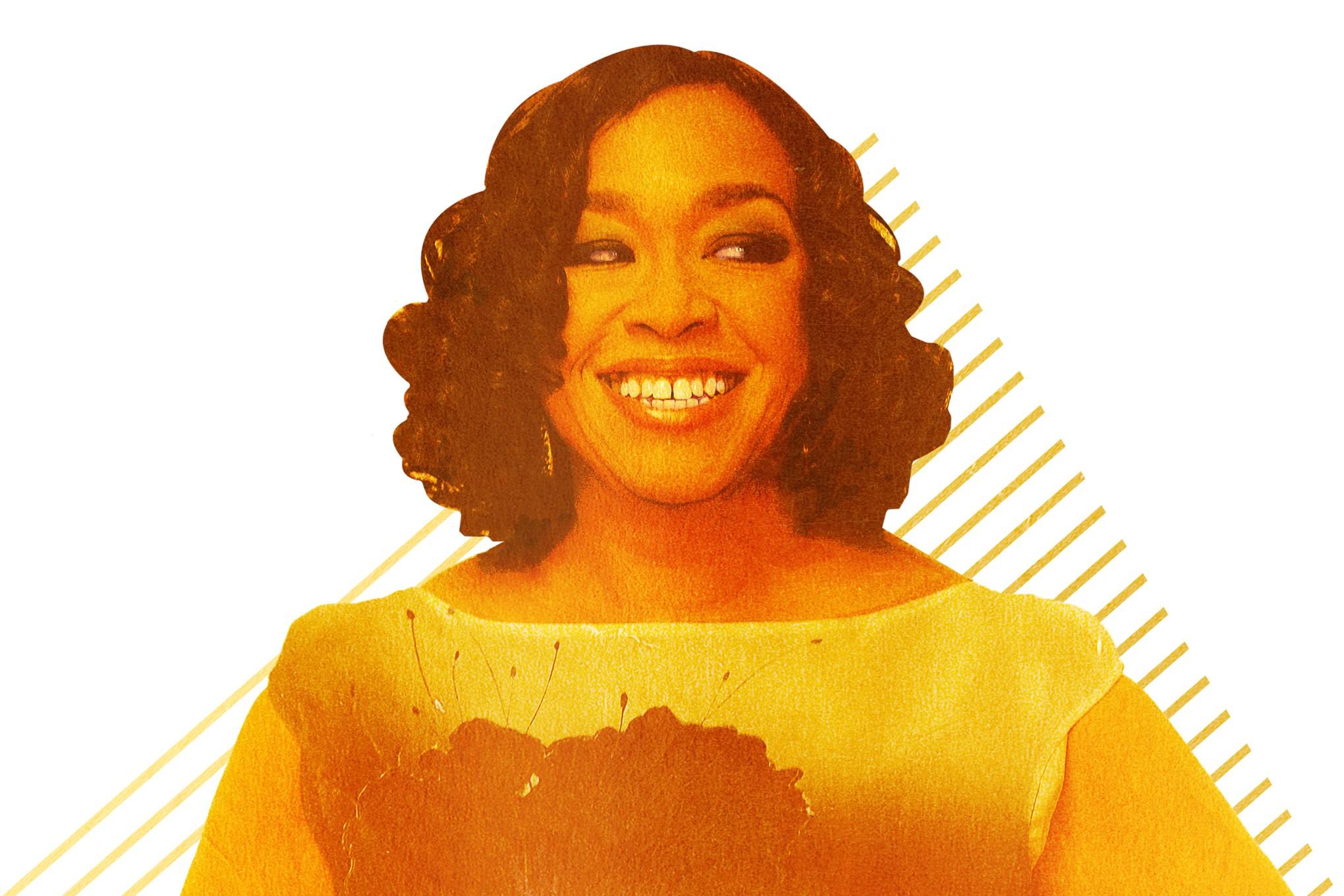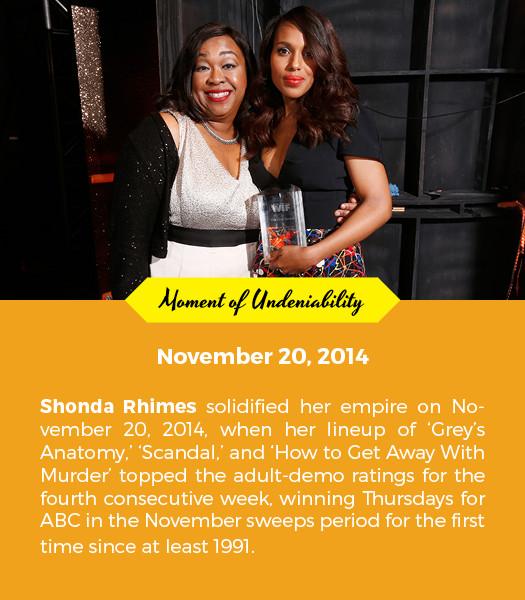Shonda Rhimes Owns a Whole Night of the Week
Here are the seven ways she uses it to make diverse, endlessly delightful television
In the Internet Age, monoculture is unachievable. But there remain a few things that we can all agree on. The Ringer is looking at this rarefied group all week. These are our Undeniables.
Shonda Rhimes wanted to build a house. (Not a real house, mind you — this is a metaphor, stay with me.) So she found a plot of land at the intersection of ABC Street and White Dude Drive. She didn’t want the house to match its neighbors, so she decided to create something new and progressive — like a big, bold midcentury-modern bungalow. (She was ahead of her time; the style wouldn’t trickle down to West Elm for another five years or so.) Some people thought the house was too tacky, but most — like, millions of her neighbors — saw it and wanted another one. So Rhimes built a second house. And then another, and another, until the landscape was littered with Rhimes homes. Now she’s an architect.
Shonda Rhimes is also a black woman whose name is most commonly followed by “most powerful woman in television.” In the past decade, she’s colonized an entire corner of network television, founded on her troika of shows, Grey’s Anatomy, Scandal, and How to Get Away With Murder. All three are relentlessly successful, influential, and imbued with Shonda’s signature touches — melodrama, diversity, a show-specific vocabulary, an insistence that you watch this right now — that are now embedded in television and pop culture’s DNA.

All of Shondaland’s trademarks can be found in Episode 16 of Grey’s Anatomy’s second season, which we’ll use as a kind of blueprint to break down Shonda’s influence. So please, cast your mind back to Sunday, February 6, 2005, when ABC aired “It’s the End of the World,” a.k.a. “The Super Bowl episode.” It guest-starred Christina Ricci and a pre–Friday Night Lights Kyle Chandler. It attracted 38.8 million viewers, making it the most watched episode of all 12 seasons of Grey’s Anatomy, and it earned Rhimes an Emmy nomination for Outstanding Writing for a Drama Series in 2006. It also crystallized a new vision for the next decade of TV.
The WTF? Plotlines
To briefly recap “It’s the End of the World”: Our lead, Dr. Meredith Grey, somehow gets her hand wrapped around a live bomb that’s lodged in the chest of a trauma patient. Dr. Miranda Bailey is in labor, while her husband is having emergency brain surgery down the hall. Then the hospital has to be evacuated — and that’s just the A-plot. George, Izzie, Alex, Addison, Dr. Burke, McDreamy, and guest star Ricci all have their own dramatic moments, including a choice “I don’t want to die” monologue from Ricci. The breakneck pace is a signature of every Shonda show: there’s an A-plot, a B-plot, a C-plot, an A-meets-C-plot, and a flashback to the future past of the A-plot, at the very least.
Ripple Effect: In 2016, the prime-time adult soap opera is now an acceptable, and sometimes even critically acclaimed, form of television. See also: Downton Abbey, Nashville, Pretty Little Liars, Jane the Virgin, and Empire. (And, real talk, Game of Thrones.)
The Will They/Will They Again Relationships
In “It’s the End of the World,” Meredith still loves Dr. McDreamy, but he’s trying very hard to love his wife, Addison. Cristina loves Dr. Burke, but both of them are robots who just like sex, maybe? George loves Meredith but, you know, he’s George. Izzie, meanwhile, just needs to get laid, so she successfully jumps Alex in the break room. In Shondaland, relationships are codependent, convoluted, usually doomed affairs that only occasionally involve love — but they always yield the best sex scenes on major network TV.
Ripple Effect: TV has less will they/won’t they baggage, and more unexpected couples — like Jessa and Adam on Girls, Rick and Michonne on The Walking Dead, Alex and Piper on Orange is the New Black, and Josh and Rebecca on Crazy Ex-Girlfriend. Meanwhile, shows likes You’re the Worst or Outlander aren’t afraid to hang plots on central romantic relationships, and to extend those relationships over several seasons. Also: The Shonda legacy means more people on TV get it with gusto no matter what size, color, or sexual orientation they are. Please watch Gabourey Sidibe’s masterful sex scene in Season 2 of Empire — Shonda would be proud.
The Vintage Heartthrobs
Apologies to George Clooney, but this Super Bowl special made Patrick Dempsey the king of looking dreamy while calmly removing a blood clot from a man’s brain during a bomb threat. Grey’s Anatomy revived Patrick Dempsey; Scandal brought back Scott Foley. How to Get Away With Murder even turned Alfred Enoch into a grown-up sexy person (as opposed to a child star from Harry Potter.) Shonda has a way with has-been hot dudes.
Ripple Effect: Scott Speedman has a show. John Stamos has a show. J.Lo has a show. Keri Russell has a show. Let’s keep it going.
The Head Bitch in Charge
As previously mentioned, Dr. Bailey spends a large part of “It’s the End of the World” in labor. Does a few lousy contractions and some husband-related drama keep her from running shit at the hospital? No, it does not. Which is typical, because Shonda’s heroines have complicated-bordering-on-ridiculous personal lives, but they also have C-suites, fat bank accounts, and several scenes an episode to demonstrate how excellent they are at their chosen profession. One does not preclude the other.
Ripple Effect: Daenerys Targaryen on Game of Thrones, Peggy Olson on Mad Men, Rachel and Quinn on Unreal, Claire Underwood on House of Cards, Mindy on The Mindy Project, and Cookie on Empire: all women who overcome wild personal issues to get stuff done.
The Cliff-hangers
At the end of “It’s the End of the World,” the possible death count is four. The possible birth count is one. The possible get-laid count is two. (Spoiler alert from the next episode: Chandler dies, a baby is born, people have sex.) Cliff-hangers aren’t new, but the Shonda trick is to use them almost every week.
Ripple Effect: Walking Dead created an 18-million viewer empire out of this weekly trick. (So did every other Shonda show, and Game of Thrones, and Empire, and Nashville, except that wasn’t technically an empire.)
The One-Night TV Event
This episode of Grey’s aired on a Sunday night, right after the Super Bowl — the original power programming block. Eventually, Grey’s moved to Thursdays, and was joined by Scandal and How to Get Away With Murder, to create Rhimes’s #TGIT. And after Rhimes started live-tweeting Scandal, a cottage industry was born.
Ripple Effects: Networks are scrambling to replicate Shonda’s OMG-worthy appointment television — and the social media attention that goes with it. (It is not a coincidence that every network television star is now practically required to tweet through each episode.)
The Diverse Cast and Crew
In this single 2005 episode, there are four non-white actors — Sandra Oh, Chandra Wilson, James Pickens Jr., and Isaiah Washington — playing beloved three-dimensional characters with real, relatable story lines. This is textbook Shonda: While the rest of Hollywood is monochromatic, Rhimes makes sure her TV shows reflect the color she sees in the world. She writes choice roles for black actresses like Viola Davis and Kerry Washington, who made history as the first black woman to land a lead role on network television in nearly 40 years. She ensures diversity in the writers’ room. And she calls out the bullshit, as it were, on her shows and in real life.
Ripple Effect: Other networks are starting to follow suit: Jane the Virgin, Black-ish, Fresh Off the Boat, Empire, Insecure — a new HBO show from former Rhimes disciple Issa Rae — are all great shows with interesting, lead roles for actors of color. It is not a full revolution, but it’s something.